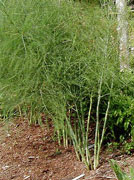


Home
Flowers &
Indoor Plants
Fruits & Nuts
Ornamentals
Vegetables
Special Topics
Resources
Glossary

Asparagus |
 |
What about it? Asparagus is a favorite spring crop among gardeners. However, it does require a considerable amount of patience - it will take 3 years to establish a productive asparagus bed. What is it used for? The young shoots of the asparagus plant are edible. Fern-like foliage will grow from the stalks. Female plants produce pea-sized red berries and the male plants produce the pollen. Because they need the energy to bear fruit, the female plants typically yield less "fleshy" edible parts than do the male plants. Where does it grow? How do we grow it? Asparagus is a perennial, and a bed can remain productive for 20 years if free from Fusarium. That's why it is so important to prepare the beds properly. Weeding is a necessity, both before planting and when weeds become threatening afterward. The fern-like foliage can grow up to 5 feet, so give the plant some growing room. It doesn't need full sun but it does best in slightly acidic soils. However, roots are prone to rotting so select a well-drained soil! What are its primary problems? Because they are around for such a long time, the asparagus' biggest threats are being overrun by perennial weeds and freedom from Fusarium root rot For weed control clear the beds every spring before the weeds go to seed to save yourself some work the following year. The asparagus beetle defoliates furns and causes misshapen spears. How do we propagate it? (by seed or transplant?) Actually, the easiest way to start asparagus is from crowns. crowns are the pencil-thin storage roots attached to an underground stem. To start an asparagus bed, dig a trench 15 inches deep and 12 inches wide. In the trench, space 9 inch high mounds 18 inches apart. Soak the crowns before you plant them and then drape them on top of these mounds, secure slightly, and cover with 2 more inches of rich topsoil. Incidentally, asparagus can be started from seeds, but it will take longer to establish a productive bed. How do we harvest and store it? Harvest when the first shoots emerge and eat the same day for optimum freshness. Pick only those spears that are thicker than a pencil. They should be about 6 or 8 inches tall. The harvest period increases as the planting ages. Stop harvesting in June so that the remaining plants can begin to manufacture carbohydrates needed for continual growth.
© Copyright, Department of Horticulture, Cornell University. |